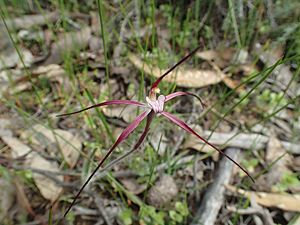Crimson spider orchid facts for kids
Quick facts for kids Crimson spider orchid |
|
|---|---|
 |
|
| Caladenia footeana in the Wandoo National Park | |
| Scientific classification | |
| Genus: |
Caladenia
|
| Species: |
footeana
|
| Synonyms | |
|
|
The crimson spider orchid, also known as Caladenia footeana, is a special type of orchid. It grows only in the south-west part of Western Australia. This means it is endemic to that area.
This orchid has a single, hairy leaf. It usually produces one or two flowers. These flowers are a lovely pinkish-red color. They also have a white part called a labellum with red stripes. The crimson spider orchid is quite small, which can make it tricky to spot in nature.
Contents
What Does It Look Like?
The crimson spider orchid is a perennial plant. This means it lives for more than two years. It's also a deciduous herb, which means its leaves fall off at certain times. It grows from an underground tuber, which is like a storage root. Often, you can find these orchids growing in small groups of up to ten plants.
Each plant has one straight, hairy leaf. This leaf is about 60 to 80 millimeters (2.4 to 3.1 inches) long. It is also about 2 to 3 millimeters (0.08 to 0.12 inches) wide.
The orchid usually has one or two flowers. These flowers are quite large, about 50 to 90 millimeters (2 to 3.5 inches) long. They are also 50 to 80 millimeters (2 to 3.1 inches) wide. The flowers grow on a stalk that is 100 to 220 millimeters (3.9 to 8.7 inches) tall.
The flowers are a dark pinkish-red color. They have maroon markings. The sepals and petals of the flower have long, thin tips that look like threads.
- The top sepal, called the dorsal sepal, stands upright. It is about 25 to 40 millimeters (1 to 1.6 inches) long. It is about 2 millimeters (0.08 inches) wide at its base.
- The side sepals, called the lateral sepals, are about 30 to 40 millimeters (1.2 to 1.6 inches) long. They are 2 to 3 millimeters (0.08 to 0.12 inches) wide at their base. These sepals spread out near the bottom, then curve or hang downwards.
- The petals are similar in size to the side sepals. They also hang downwards in a similar way.
The special lip of the flower is called the labellum. It is 9 to 12 millimeters (0.35 to 0.47 inches) long. It is also 6 to 8 millimeters (0.24 to 0.31 inches) wide. The labellum is creamy-white with red lines spreading across it. The sides of the labellum have short, blunt teeth. The very tip of the labellum curves downwards.
Along the center of the labellum, there are two rows of reddish bumps. These bumps are shaped like tiny anvils and are called calli. The crimson spider orchid blooms from July to early October.
How It Got Its Name
The Caladenia footeana was first officially described in 2001. This was done by two botanists, Stephen Hopper and Andrew Phillip Brown. They found a sample of the orchid near a creek in Cockleshell Gully, close to Jurien Bay. Their description was then published in a scientific journal called Nuytsia.
The second part of its scientific name, footeana, is a special honor. It was chosen to remember Herbert Foote. He was the first president of an Australian orchid study group.
Where It Lives
The crimson spider orchid grows in several areas of Western Australia. These areas include Cranbrook and Binnu. You can find it in different natural regions. These include the Avon Wheatbelt, Coolgardie, Geraldton Sandplains, Jarrah Forest, and Swan Coastal Plain. It likes to grow in woodlands or thick shrublands. Sometimes, it can even be found on granite rock outcrops.
Is It Protected?
The Government of Western Australia's Department of Parks and Wildlife has looked at the crimson spider orchid. They have classified it as "not threatened." This means that currently, there are enough of these orchids in the wild, and they are not considered to be in danger of disappearing.
Images for kids



